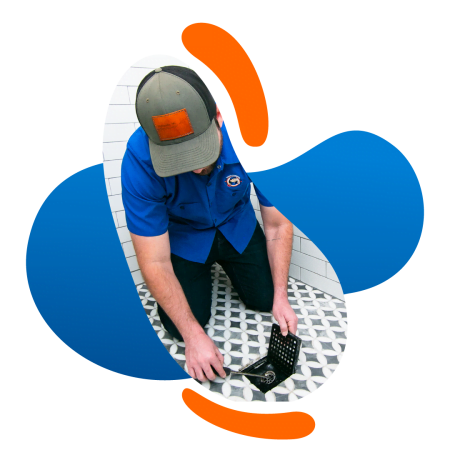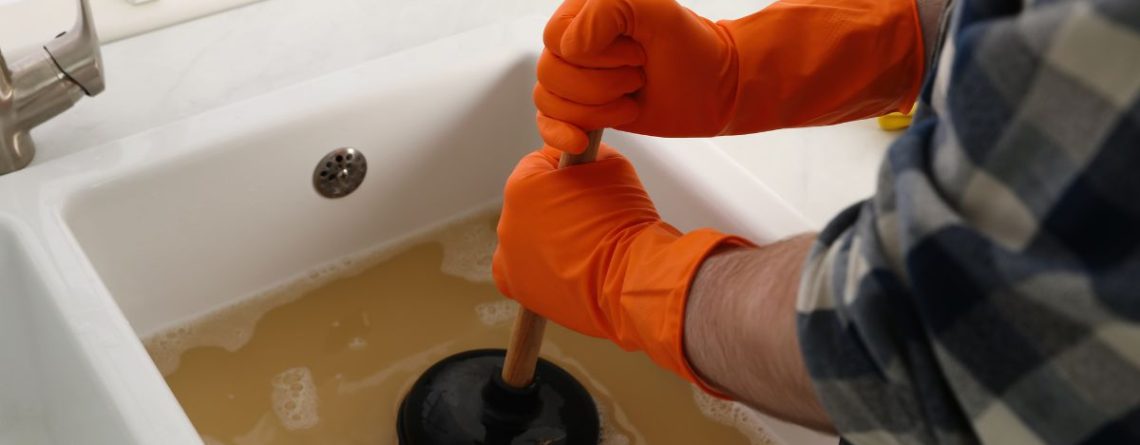Common Drain Problems
Don't let your drains become a daily drama. From the slow-draining sink that greets you every morning to the ominous bubbling sound from your toilet, drain problems can turn from minor annoyances into major headaches overnight. Whether it's the frustration of a clogged drain, the concern over slow drainage throughout your home, the confusion of hearing gurgling noises after flushing, or the displeasure of encountering foul odors, these common issues signal that not all is well beneath your feet. Each scenario, whether it be standing water in the bathtub or a whole house backup, tells a tale of neglected pipes and potential for significant disruption in your daily life.

Slow Draining Bathroom Sink, Shower, and Bathtub
One of the most common drain issues experienced in households is a slow-draining sink, shower, or bathtub. This frustrating problem often stems from a buildup of hair, soap scum, and other debris that accumulates over time, obstructing water flow and leading to a gradually worsening drain clog. In the early stages, the slow drain might seem like a minor inconvenience, but if left unaddressed, it can escalate into a completely blocked pipe, causing water to back up and potentially lead to more serious plumbing issues.
Remedies for Slow Drains
Addressing slow drains does not always require professional help right away. Here are some DIY solutions:
- Use a Plumbing Plunger: Aim to use a plunger designed specifically for sinks or bathtubs to dislodge minor clogs efficiently.
- Baking Soda and Vinegar Method: Pour a mixture of baking soda and vinegar down the drain.
- Wait about 15 minutes.
- Follow up with hot water to help break down organic blockages.
- Manual Plumbing Snake: For more stubborn clogs, gently insert a manual plumbing snake into the drain to remove the obstruction.
- Preventative Measures: Implement the use of drain protectors to catch hair and other debris, reducing the likelihood of future slow drains.
"An ounce of prevention is worth a pound of cure. Regular maintenance and simple precautions can save you from the unnecessary aggravation and cost of extensive repairs."
Common Clogged Toilet Problems
Clogged toilets are another prevalent issue within the home, posing significant inconvenience and potential for embarrassment. These blockages are typically caused by attempting to flush too much toilet paper, feminine hygiene products, wet wipes, or even items that are non-flushable by design. Symptoms of a clogged toilet can range from water rising alarmingly in the bowl to unpleasant overflows that require immediate action. Additionally, recurrent clogs could indicate deeper plumbing issues, such as problems with your home’s sewer line. Ignoring or inadequately addressing these signs can lead to more severe and costly plumbing emergencies, highlighting the importance of understanding and promptly resolving the root causes of toilet clogs.

Remedies for Clogged Toilet
Effective solutions for addressing clogged toilets can be both simple and quick, helping to mitigate the problem before it exacerbates. Here are some practical approaches:
- Plunger: Utilize a flange plunger, designed specifically for toilets, to create a seal and suction necessary to dislodge clogs.
- Toilet Auger: For more difficult blockages that a plunger can't clear, a toilet auger (closet auger) can reach deeper into the drain to break up or retrieve obstructions.
- Enzymatic Cleaners: These cleaners use natural bacteria and enzymes to break down organic waste in the pipes, ideal for maintenance rather than immediate unclogging.
- Hot Water and Dish Soap: Pour a mixture of hot water (not boiling, to avoid damaging porcelain) and dish soap into the bowl. The soap can help lubricate the clog while the hot water softens it, aiding in removal.
- Professional Plumbing Services: When home remedies fail, or if clogs persist, it's prudent to call in professional plumbers who can accurately diagnose and resolve underlying issues.
Remember, prevention is key. Avoid flushing anything aside from waste and toilet paper, and consider regular use of enzymatic cleaners to maintain clear pipes.
Kitchen Sink Drain Problems and Garbage Disposal Issues

The kitchen sink is one of the most frequently used fixtures in a home, playing a crucial role in daily cleaning and cooking activities. A unique component of many kitchen sinks is the garbage disposal, which is designed to shred food waste into pieces small enough to pass through the plumbing system. However, despite its convenience, the integration of garbage disposal with the kitchen sink drain often leads to specific issues.
Most Common Drain Problems in Kitchen Sink
- Clogs from Grease and Food Particles: One of the most prevalent issues in kitchen sinks is clogging due to the accumulation of grease, oil, and unprocessed food particles. These substances can solidify or get stuck in the pipes, severely obstructing water flow.
- Foul Odors: Continuous disposal of food waste and the buildup of decomposing food particles can lead to unpleasant smells emanating from the kitchen sink drain. This is often a sign of the need for thorough cleaning or unclogging.
- Damaged Pipes and Leaks: Persistent blockages can increase pressure in the pipes, leading to cracks or leaks. These are not only problematic for the kitchen sink drain but can also cause water damage beneath the sink.
- Malfunctioning Garbage Disposal: Garbage disposals can jam or malfunction if they are overloaded, run without water, or if inappropriate materials (like bones, fibrous vegetables, or coffee grounds) are fed into them. This not only affects the disposal unit but can also lead to backups and slow draining in the sink.
Garbage Disposal Use and Maintenance Tips

To ensure the longevity and efficiency of your garbage disposal and avoid common kitchen sink problems, consider the following tips:
- Run Cold Water: Always run cold water during and for several minutes after disposal use to help move the waste along.
- Regular Cleaning: Clean your disposal regularly using ice cubes and rock salt, which help to sharpen the blades and remove built-up residue.
- Avoid Hard or Fibrous Materials: Items such as bones, coffee grounds, and fibrous vegetables like celery can jam or dull the disposal blades.
- Proper Waste Disposal: Use the garbage disposal for biodegradable food waste only. Non-food items can damage the system.
- Dealing with Foul Odors: Freshen up your disposal by grinding citrus fruit peels or using a mixture of baking soda and vinegar to eliminate unpleasant smells.
- Prevent Clogs: Be mindful not to overload the disposal with too much waste at once and avoid disposing of grease and oil, which can solidify and clog the pipes.
- Utilize Professional Help: For persistent problems or malfunctions, seeking professional assistance can prevent further damage and ensure proper functionality.
Adhering to these guidelines can significantly mitigate the risk of clogs, odors, and mechanical issues, keeping your kitchen sink and garbage disposal running smoothly.
Sewer Main-Line Drain Problems
The sewer main-line is a crucial component of home plumbing systems, effectively removing wastewater from the home to treatment facilities or septic systems. However, several issues can impair its functionality, often leading to significant inconvenience and potentially costly repairs.
Whole-House Drain Backup
- Symptoms: When the sewer main-line is clogged, all household drains may experience backup simultaneously. This is most noticeable when use of any water fixture in the house, like sinks or showers, leads to water backup in toilets or shower drain, indicating a blockage in the main sewer line.
- Causes: Common causes include flushing of inappropriate materials, tree root infiltration, or a buildup of grease and other substances.
Bubbling and Gurgling Noises
- Symptoms: Bubbling or gurgling sounds from toilets or drains can indicate that the sewer line is clogged. Because the air trapped by the blockage cannot escape through the vent stack (the pipe on your roof), it moves through the water in the toilet bowl or drain traps instead.
- Causes: The primary cause is a blockage in the sewer line that prevents normal airflow through the plumbing system.
Breached Sewer Line

- Symptoms: Signs of a breached sewer line can include unexpected lush spots in the yard, foul odors, or unexplained pools of water.
- Sand and Roots: Tree roots seeking moisture can grow into pipes through tiny cracks, expanding over time and eventually causing a breach. Sand can also enter through these cracks, further complicating the blockage.
- Aging Pipes: Older pipes made of cast iron or clay are particularly susceptible to breaking or corroding over time.
Belly in Sewer Line
- Symptoms: A belly, or sagging area, in the sewer line can lead to accumulation of waste and debris at the sag's lowest point, causing repeated blockages.
- Improper Installation: If the sewer line was not properly supported during installation, parts of the pipe can sink over time, creating a belly.
- Ground Conditions: Changes in the surrounding soil, such as settling or erosion, can also lead to a belly in the sewer line.
Solutions to Sewer Main-Line Clogs
Dealing with sewer main-line issues requires a nuanced approach as these problems are intricate and can be caused by a variety of factors. It is crucial to have these issues diagnosed by a professional plumber who possesses the experience and tools necessary to accurately determine the root cause of the problem. Whether it is a simple clog or a more complex breach in the sewer line, professional assessment is key.
In cases where the sewer pipe is damaged, breached, or has a belly, the solution often involves either partial or complete replacement of the affected sections of the pipe. Such extensive work requires the expertise of a licensed plumbing contractor, who is not only trained to perform the replacement safely and efficiently but is also familiar with the local codes and regulations. The contractor will need to pull the necessary permits from the local municipality before proceeding with the work. This ensures that all repairs or replacements are done in compliance with local building standards, safeguarding the health and safety of the property's inhabitants as well as the surrounding environment.
IMPORTANT! Request Sewer Camera Inspection:

To ensure a comprehensive understanding of sewer main-line issues, homeowners should ask their plumber to use a sewer line camera for inspection. This advanced technology allows for a detailed view and recording of the sewer pipe's condition from the inside, revealing any blockages, damages, belly or irregularities. Requesting to see the footage of the damage can provide valuable insight into the problem and help in making informed decisions regarding the necessary repairs or replacements. Additionally, obtaining a copy of the video recording can be beneficial for future reference or if any disputes arise. This proactive approach can significantly aid in accurately diagnosing and effectively addressing sewer main-line issues.
Addressing these issues can range from simple maintenance to complex repairs, often requiring the expertise of professional plumbers equipped with specialized tools. Early detection and response are key to preventing minor problems from escalating into major disruptions.
In conclusion, while facing plumbing issues like clogged drains, faulty garbage disposals, or main-line sewer problems can seem daunting, understanding the most common issues and applying proper maintenance tips can help mitigate many of these problems.
However, certain situations require professional attention to prevent further damage and ensure your plumbing system is functioning correctly. If you're still struggling with persistent plumbing issues despite your best efforts, it's crucial to seek the expertise of a licensed and insured professional. Choice Plumbing Orlando stands ready to provide top-quality plumbing services to address any issue, big or small. Our team of experts is equipped with the knowledge and tools to offer effective solutions, ensuring your plumbing system is restored to its optimal condition. Don't let plumbing problems disrupt your life, contact Choice Plumbing Orlando today and experience the peace of mind that comes with professional plumbing solutions.

